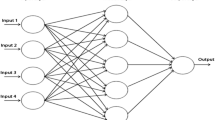Abstract
In this paper, a remote-control system for a six-degree-of-freedom robotic arm that uses an indirect teaching method is proposed. In the indirect teaching method, an essential time delay occurs, which degrades the system performance. To overcome this time delay, which can be modeled using a Smith predictor, a model neural network (MNN) has been adopted. The Smith predictor is a model-based algorithm that is uncertain and prone to interference. In this study, the MNN has been utilized in an effective manner to model the system to support the Smith predictor algorithm. Using this time delay compensation, the outer loop proportional, integral, and derivative (PID) control gains are adjusted in an optimal manner through a PID neural network (PIDNN) to ensure that the robotic arm follows human commands precisely. By using the PIDNN proposed in this paper, the time required for indirect teaching application of the robot arm can be reduced.



















Similar content being viewed by others
Change history
23 September 2021
A Correction to this paper has been published: https://doi.org/10.1007/s12541-021-00580-4
References
F. Cao, Y. Li, G. Zhang, J. Wang, X. Chen, and Y. Zhao, (2016)"Novel humanoid dual-arm grinding robot," 12th IEEE/ASME International Conference on Mechatronic and Embedded Systems and Applications (MESA), IEEE, pp. 1–6.
P. K. Kim et al., (2016)"Dual-arm robot box taping with kinesthetic teaching," 13th International Conference on Ubiquitous Robots and Ambient Intelligence (URAI), IEEE, pp. 555–557.
Y. Zhang, Z. Lu, C. Wang, C. Liu, and Y. Wang (2018) "Voice control dual arm robot based on ROS system," IEEE International Conference on Intelligence and Safety for Robotics (ISR), IEEE, pp. 232–237.
P. Dhepekar and Y. G. Adhav (2016) "Wireless robotic hand for remote operations using flex sensor," International Conference on Automatic Control and Dynamic Optimization Techniques (ICACDOT), IEEE, pp. 114–118.
Y. Torroja, A. López, J. Portilla, and T. Riesgo (2015) "A serial port based debugging tool to improve learning with arduino," Conference on Design of Circuits and Integrated Systems (DCIS), IEEE, pp. 1–4.
R. Mishra, A. Javed (2018) "ROS based service robot platform," 4th International Conference on Control, Automation and Robotics (ICCAR), IEEE, pp. 55–59.
B. A. M. Zain, M. O. Tokhi, S. F. Toha (2009) "PID-based control of a single-link flexible manipulator in vertical motion with genetic optimisation," Third UKSim European Symposium on Computer Modeling and Simulation, IEEE, pp. 355–360.
R. K. Mandava and P. R. Vundavalli (2015) "Design of PID controllers for 4-DOF planar and spatial manipulators," International Conference on Robotics, Automation, Control and Embedded Systems (RACE), IEEE, pp. 1–6.
N. K. Jaiswal and V. Kumar (2014) "Comparison between conventional pid and fuzzy pid supervisor for 3-dof scara type robot manipulator," IEEE Students' Conference on Electrical, Electronics and Computer Science, IEEE, pp. 1–5.
J. Duda (2020) "Parametric optimization of a Second Order Time Delay System with a PI-Controller," 21th International Carpathian Control Conference (ICCC), IEEE, pp. 1–6.
J. Duda (2016) "Lyapunov matrices approach to the parametric optimization of a time delay system with a PI controller," 21st International Conference on Methods and Models in Automation and Robotics (MMAR), pp. 1206–1210.
Zhang, W. D., & Sun, Y. X. (1996). Modified Smith predictor for controlling integrator/time delay processes. Industrial Engineering Chemistry Research, 35(8), 2769–2772.
A. Maddi, A. Guessoum, and D. Berkani (2015) "Design of nonlinear PID-smith predictor controllers with large time delays," Third World Conference on Complex Systems (WCCS), IEEE, pp. 1–4.
Tan, F., Li, H.-X., & Shen, P. (2018). Smith predictor-based multiple periodic disturbance compensation for long dead-time processes. International Journal Control, 91(5), 999–1010.
Bettayeb, M., Mansouri, R., Al-Saggaf, U., & Mehedi, I. M. (2017). Smith predictor based fractional-order-filter PID controllers design for long time delay systems. Asian Journal Control, 19(2), 587–598.
Truong, D. Q., Ahn, K. K., & Trung, N. T. (2012). Design of an advanced time delay measurement and a smart adaptive unequal interval grey predictor for real-time nonlinear control systems. IEEE Transactions Industrial Electronics, 60(10), 4574–4589.
Krstic, M., Kokotovic, P. V., & Kanellakopoulos, I. (1995). Nonlinear and adaptive control design. Berlin: Wiley.
Subudhi, B., & Jena, D. (2011). A differential evolution based neural network approach to nonlinear system identification. Applied Soft Computing, 11(1), 861–871.
Volyanskyy, K. Y., Haddad, W. M., & Calise, A. J. (2009). A new neuroadaptive control architecture for nonlinear uncertain dynamical systems: beyond σ- and e-modifications. IEEE Transactions Neural Networks, 20(11), 1707–1723.
Liu, D., Wang, D., Zhao, D., Wei, Q., & Jin, N. (2012). Neural-network-based optimal control for a class of unknown discrete-time nonlinear systems using globalized dual heuristic programming. IEEE Transactions Automation Science Engineering, 9(3), 628–634.
Jinhyun, P., Dongeon, K., Kiseo, K., & Jangmyung, L. (2019). “Collision Detection Algorithm for 6-DOF Manipulator Through Current Analysis,.” Journal Institute Electronics Information Engineers. https://doi.org/10.5573/ieie.2019.56.4.110
Zeng, G.-Q., Xie, X.-Q., Chen, M.-R., & Weng, J. (2019). Adaptive population extremal optimization-based PID neural network for multivariable nonlinear control systems. Swarm Evolutionary Computation, 44, 320–334.
L. Changhua, S. Hua (2011) "Design of electric loading system in flight simulator based on PIDNN," International Conference on Mechatronic Science, Electric Engineering and Computer (MEC), IEEE, pp. 2623–2626.
Acknowledgements
This research is based on work supported by the Ministry of Trade, Industry & Energy (MOTIE, Korea) under the Industrial Technology Innovation Program, No. 10073147.
Author information
Authors and Affiliations
Corresponding author
Additional information
Publisher's Note
Springer Nature remains neutral with regard to jurisdictional claims in published maps and institutional affiliations.
The original online version of this article was revised: Due to an unfortunate oversight during the correction process the author name of Dongeun Kim has been given incorrect. Further the biography of Jinuk Bang has been given erroneously.
Rights and permissions
About this article
Cite this article
Zhang, X., Kim, D., Bang, J. et al. Time Delay Compensation of a Robotic Arm based on Multiple Sensors for Indirect Teaching. Int. J. Precis. Eng. Manuf. 22, 1841–1851 (2021). https://doi.org/10.1007/s12541-021-00542-w
Received:
Revised:
Accepted:
Published:
Issue Date:
DOI: https://doi.org/10.1007/s12541-021-00542-w




